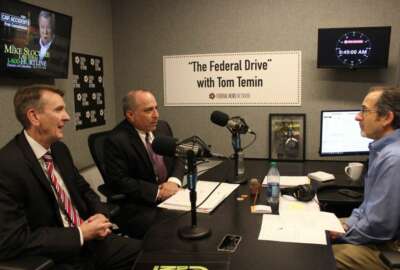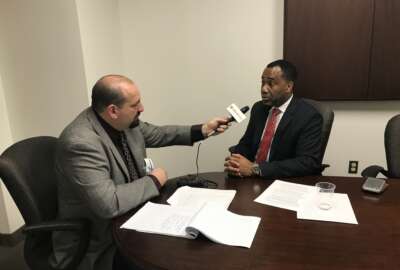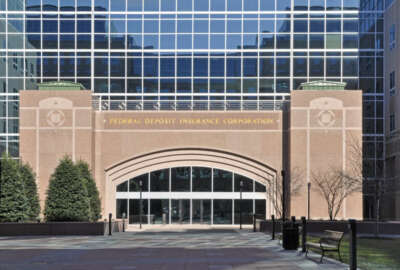
FDIC kicking off academic challenge
Do community banks have any real effect on local economic development. The FDIC is asking students that question.
Best listening experience is on Chrome, Firefox or Safari. Subscribe to Federal Drive’s daily audio interviews on Apple Podcasts or PodcastOne.
Do community banks have any real effect on local economic development. The FDIC is asking kids that question. Not just any kids, but teams of college students who participate in the agency’s academic challenge. Round one of the challenge is already underway. for more, Federal Drive with Tom Temin turned to the deputy director of FDIC’s Division of Research and Regulatory Analysis. Philip Shively.
Interview transcript:
Tom Temin: Mr. Shively, good to have you on.
Philip Shively: It’s very good to be with you.
Tom Temin: Well tell us about this challenge. What is the purpose of it? First of all, why would FDIC launch such a challenge?
Philip Shively: Well, the FDIC wants to engage with young people get them to think about the banking system and the stability of the system, and how that plays into their local economic activity. We want them to be very much aware of how banks effects the economy. So I think that’s the root of it.
Tom Temin: And what do you mean by community bank? Because I’m not sure they exist anymore. Most banks seem to be sucked up by the giant five or six national banks.
Philip Shively: That’s right. There aren’t as many as there used to be, I would say 35 years ago, we had about 18,000 banks in the United States. And these days, it’s a little over 5,000 banks. So community banks, they’re not as many as there used to be, but they still do exist. And I think what really defines a community bank is the type of lending they do, they do relationship lending, where they know their customer, and they look beyond the numbers on a piece of paper and really engage with the people that they’re dealing with.
Tom Temin: Alright, so it would seem kind of an obvious answer whether community banks have any effect on economic development. So how is this a challenge question? I guess it’s probably not as simple as I think it is.
Philip Shively: Well, you hit the nail on the head early on when you said that there aren’t nearly as many community banks. We know that economic activity is driven by small businesses. Small businesses rely on community banks. So with that decline in community banks, we want our college students to look at this issue and see what that impact is on local economic development. Is there an impact? Have the larger banks come in and fill that gap? Or is there a need for more community banks in local areas? So I think it’s a good way for our students to engage in this question.
Tom Temin: So to answer that question, then it sounds like the teams will have to do a lot of research to get some evidence one way or the other?
Philip Shively: They will. And as part of this academic challenge that the FDIC has developed, we have put together some publicly available data. Every quarter, banks send in call report data very detailed financial information. Each individual bank does this. We have gathered that in one handy spot to make that available for students in a spreadsheet. We’ve also put together publicly available data from the Bureau of Economic Analysis, they have regional data that is available, and we have gathered that as well. Students are free to use any other publicly available data that they want to use. But we have developed datasets that they can use, and we would expect them to start with that and to analyze the questions.
Tom Temin: Tell us about the typical team makeup that you expect to participate. Are they mostly economics majors or finance majors or business majors, and maybe some of the schools that might be participating?
Philip Shively: Well, we reached out to nearly 500 schools to the economics departments. We would anticipate that most of the students would be economic students, it could be that a professor uses this as part of a class project. It could be that in economics club within a college or university takes us on as a challenge. We might also get undergraduate business students. But I think the primary student will be an economics major. We’re looking for teams of five or six students where it’s large enough that it’s a group project, but it’s small enough that each individual can make a meaningful contribution to the team effort.
Tom Temin: What is the deliverable? An essay, a chart, or what is it you expect to get in as their submissions?
Philip Shively: We’re going to have two rounds to this competition. The first round is going to be a written submission. It’s due on November 20. And we expect that to be roughly a 10 page document including charts and executive summary. So relatively short and to the point but again, a written document in the first round. We will evaluate those and choose five winners, so to speak, or the best submissions and invite those for a second round. The second round will be an in person presentation at the FDIC. And from that, we’ll have a panel of judges who will evaluate the presentations, the content, and choose an overall winner for the conference. next spring.
Tom Temin: And the winners receive what?
Philip Shively: Well, the winners will receive a plaque. It’s going to be recognition for a job well done. And the plan is to have them be awarded with a plaque.
Tom Temin: Got it. And I wonder at the back of all this, the FDIC sees potential candidates for employment some point at the FDIC?
Philip Shively: Absolutely. We want to engage with young people, with college students. And one of the objectives is to show them what a career in banking is about. And some of these students we would anticipate will choose a career in banking, perhaps in the FDIC, on the regulatory side, perhaps in a bank, a local bank, or perhaps in another type of financial institution. But we would anticipate that this will drive some interest that otherwise might not be there for students to pursue a career in banking or finance.
Tom Temin: Sure. And by the way, who does the judging on the quality of the submissions?
Philip Shively: Well, we have a panel of economists who are going to be judging the first round. We anticipate getting many submissions in the first round. We’re going to have a panel of economists evaluate those. And then the second round, we’re going to have a panel of expert judges chosen from different disciplines throughout the FDIC, from our supervision group to our large bank resolution group to our receivership group, and also FDIC economists. So we anticipate a panel of five judges who will evaluate the in person presentations.
Tom Temin: As the Deputy Director of the Division of Research and Regulatory Analysis, just briefly tell us what your division does.
Philip Shively: Well, our division has several functions. We are responsible for deposit insurance, the pricing of deposit insurance, and the interacting with banks. We also have our economists that do research, academic type research, and interact with the academic community. We have a statistics branch that collects this call report data that I mentioned early on — very detailed financial statement data, we collect that on a quarterly basis. We have a group that does international work. We are, if I may say, the premier deposit insurance organizations throughout the world, and a lot of the other countries have looked to us over the last 10 years since the financial crisis 10 years ago for support in either development or improvements in deposit insurance. So we have an international group that reaches out to folks in other countries to help them in their endeavors.
Tom Temin: Alright, and getting back to a final question on the academic challenge. This is the first time, right, that you are having one?
Philip Shively: That’s correct. This is the first time we’re going to launch this, the academic challenge. This is the first time. And we plan on doing this on an annual basis and to have this be an ongoing interaction with the academic community with students.
Tom Temin: We will be looking forward to the outcome. Philip Shively is Deputy Director of the Division of Research and Regulatory Analysis at the FDIC. Thanks so much for joining me.
Philip Shively: Well, thank you for having me.
Copyright © 2025 Federal News Network. All rights reserved. This website is not intended for users located within the European Economic Area.
Tom Temin is host of the Federal Drive and has been providing insight on federal technology and management issues for more than 30 years.
Follow @tteminWFED





